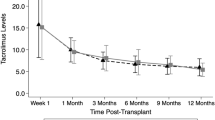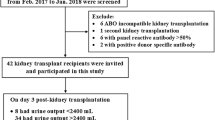Abstract
Background Kidney transplant recipients (KTR) receive fixed daily doses of mycophenolate sodium as part of the immunosuppressive regimen. Dose reductions occur primarily due to adverse events and may be associated with an increased risk of acute rejection and graft loss. Objectives To evaluate the tolerability of mycophenolate in kidney transplant recipients receiving tacrolimus and prednisone. Setting The study was performed at Hospital do Rim, Federal University of São Paulo in Brazil. Method This was a retrospective cohort study including 506 patients. Tolerability of mycophenolate sodium was classified into the following groups: Temporary reduction (TR), definitive reduction (DR), temporary interruption (TI), permanent discontinuation (PD) and without modification (WM). Main outcome measure The cause of mycophenolate dose change and its influence on rejection-free survival during the first 3 years after transplantation. Results The cumulative incidence of dose change was 51.2% (11%TR, 44%DR, 24%TI, and 21%PD). Gastrointestinal (45.3%), infection (31.9%) and hematological (14.9%) systems accounted for most of the dose changes. The adverse events with higher incidence were diarrhea, cytomegalovirus (CMV) infection and leukopenia. Changes in dose of mycophenole were associated with reduced acute rejection-free survival compared with patients WM group (71.4%TR, 58.9%DR, 56.7%TI, 53.7%PD vs. 74.2%WM, p = 0.020). Only patients with PD showed inferior patient (59.3% vs. 94.4%, p = 0.001) and death-censored graft (83.3% vs. 92.5%, p = 0.074) survivals compared to patients WM. Conclusion In this cohort, changes in the dose of mycophenolate were associated with increased risk of acute rejection and permanent discontinuation was associated with inferior patient and graft survival.





Similar content being viewed by others
Abbreviations
- AUC-MPA:
-
Area under the curve of mycophenolic acid
- BPAR:
-
Biopsy-proven acute rejection
- CMV:
-
Cytomegalovirus
- CTCAE:
-
Common terminology criteria for adverse events
- DGF:
-
Delayed graft function
- DNA:
-
Deoxyribonucleic acid
- DR:
-
Definitive reduction
- IMPDH:
-
Inosine monophosphate dehydrogenase
- MMF:
-
Mycophenolate mofetil
- MPA:
-
Mycophenolate acid
- MPS:
-
Mycophenolate sodium
- PD:
-
Permanent discontinuation
- PRED:
-
Prednisone
- r-ATG:
-
Rabbit anti-thymocyte globulin
- RNA:
-
Ribonucleic acid
- TAC:
-
Tacrolimus
- TI:
-
Temporary interruption
- TR:
-
Temporary reduction
- WM:
-
Without modification
References
Allison AC, Eugui EM. Purine metabolism and immunosuppressive effects of mycophenolate mofetil (MMF). Clin Transplant. 1996;10(1 Pt 2):77–84.
Halloran P, Mathew T, Tomlanovich S, Groth C, Hooftman L, Barker C. Mycophenolate mofetil in renal allograft recipients: a pooled efficacy analysis of three randomized, double-blind, clinical studies in prevention of rejection. The International Mycophenolate Mofetil Renal Transplant Study Groups. Transplantation. 1997;63(1):39–47.
Sollinger HW. Mycophenolate mofetil for the prevention of acute rejection in primary cadaveric renal allograft recipients. U.S. Renal Transplant Mycophenolate Mofetil Study Group. Transplantation. 1995;60(3):225–32.
Keown P, Häyry P, Morris P, Stiller C, Barker C, Carr L. A blinded, randomized clinical trial of mycophenolate mofetil for the prevention of acute rejection in cadaveric renal transplantation. Transplantation. 1996;61(7):1029–37.
Behrend M. Adverse gastrointestinal effects of mycophenolate mofetil: aetiology, incidence and management. Drug Saf. 2001;24(9):645–63.
Pelletier RP, Akin B, Henry ML, Bumgardner GL, Elkhammas EA, Rajab A, et al. The impact of mycophenolate mofetil dosing patterns on clinical outcome after renal transplantation. Clin Transplant. 2003;17(3):200–5.
Budde K, Curtis J, Knoll G, Chan L, Neumayer HH, Seifu Y, et al. Enteric-coated mycophenolate sodium can be safely administered in maintenance renal transplant patients: results of a 1-year study. Am J Transplant. 2004;4(2):237–43.
Salvadori M, Holzer H, de Mattos A, Sollinger H, Arns W, Oppenheimer F, et al. Enteric-coated mycophenolate sodium is therapeutically equivalent to mycophenolate mofetil in de novo renal transplant patients. Am J Transplant. 2004;4(2):231–6.
Salvadori M, Bertoni E, Budde K, Holzer H, Civati G, Lien B, et al. Superior efficacy of enteric-coated mycophenolate vs mycophenolate mofetil in de novo transplant recipients: pooled analysis. Transplant Proc. 2010;42(4):1325–8.
Pietruck F, Abbud-Filho M, Vathsala A, Massari PU, Po-Huang L, Nashan B. Conversion from mycophenolate mofetil to enteric-coated mycophenolate sodium in stable maintenance renal transplant patients: pooled results from three international, multicenter studies. Transplant Proc. 2007;39(1):103–8.
Sollinger HW, Sundberg AK, Leverson G, Voss BJ, Pirsch JD. Mycophenolate mofetil versus enteric-coated mycophenolate sodium: a large, single-center comparison of dose adjustments and outcomes in kidney transplant recipients. Transplantation. 2010;89(4):446–51.
Budde K, Dürr M, Liefeldt L, Neumayer HH, Glander P. Enteric-coated mycophenolate sodium. Expert Opin Drug Saf. 2010;9(6):981–94.
Helderman JH, Goral S. Gastrointestinal complications of transplant immunosuppression. J Am Soc Nephrol. 2002;13(1):277–87.
van Gelder T, Klupp J, Barten MJ, Christians U, Morris RE. Comparison of the effects of tacrolimus and cyclosporine on the pharmacokinetics of mycophenolic acid. Ther Drug Monit. 2001;23(2):119–28.
Kaplan B, Meier-Kriesche HU, Minnick P, Bastien MC, Sechaud R, Yeh CM, et al. Randomized calcineurin inhibitor cross over study to measure the pharmacokinetics of co-administered enteric-coated mycophenolate sodium. Clin Transplant. 2005;19(4):551–8.
Maes BD, Dalle I, Geboes K, Oellerich M, Armstrong VW, Evenepoel P, et al. Erosive enterocolitis in mycophenolate mofetil-treated renal-transplant recipients with persistent afebrile diarrhea. Transplantation. 2003;75(5):665–72.
von Moos S, Cippà PE, Wüthrich RP, Mueller TF. Intestinal infection at onset of mycophenolic acid-associated chronic diarrhea in kidney transplant recipients. Transpl Infect Dis. 2016;18(5):721–9.
Dalle IJ, Maes BD, Geboes KP, Lemahieu W, Geboes K. Crohn’s-like changes in the colon due to mycophenolate? Colorectal Dis. 2005;7(1):27–34.
Arslan H, Inci EK, Azap OK, Karakayali H, Torgay A, Haberal M. Etiologic agents of diarrhea in solid organ recipients. Transpl Infect Dis. 2007;9(4):270–5.
Ekberg H, Tedesco-Silva H, Demirbas A, Vítko S, Nashan B, Gürkan A, et al. Reduced exposure to calcineurin inhibitors in renal transplantation. N Engl J Med. 2007;357(25):2562–75.
Service. USDoHaH. Common terminology criteria for adverse event (CTACAE), v. 4. National Institutes of Health 2009. p. 3–77.
Bolin P, Gohh R, Kandaswamy R, Shihab FS, Wiland A, Akhlaghi F, et al. Mycophenolic acid in kidney transplant patients with diabetes mellitus: does the formulation matter? Transplant Rev (Orlando). 2011;25(3):117–23.
van Gelder T, Silva HT, de Fijter H, Budde K, Kuypers D, Mamelok RD, et al. How delayed graft function impacts exposure to mycophenolic acid in patients after renal transplantation. Ther Drug Monit. 2011;33(2):155–64.
Staatz CE, Tett SE. Clinical pharmacokinetics and pharmacodynamics of mycophenolate in solid organ transplant recipients. Clin Pharmacokinet. 2007;46(1):13–58.
van Gelder T, Shaw LM. The rationale for and limitations of therapeutic drug monitoring for mycophenolate mofetil in transplantation. Transplantation. 2005;80(2 Suppl):S244–53.
Kuypers DR. Immunosuppressive drug monitoring: what to use in clinical practice today to improve renal graft outcome. Transpl Int. 2005;18(2):140–50.
van Gelder T, Silva HT, de Fijter JW, Budde K, Kuypers D, Tyden G, et al. Comparing mycophenolate mofetil regimens for de novo renal transplant recipients: the fixed-dose concentration-controlled trial. Transplantation. 2008;86(8):1043–51.
Pacheco e Silva Filho A, Manfro RC, Contieri FL, Mazzali M, Garcia VD, Carvalho DEB, et al. Evaluation of tolerability of enteric-coated mycophenolate sodium versus mycophenolate mofetil in de novo renal transplantation. J Bras Nefrol. 2015;37(3):291–6.
Song AT, Abdala E, Bonazzi PR, Bacchella T, Machado MC. Does mycophenolate mofetil increase the risk of cytomegalovirus infection in solid organ transplant recipients?–A mini-review. Braz J Infect Dis. 2006;10(2):132–8.
Sommerer C, Glander P, Arns W, Ariatabar T, Kramer S, Vogel EM, et al. Safety and efficacy of intensified versus standard dosing regimens of enteric-coated mycophenolate sodium in de novo renal transplant patients. Transplantation. 2011;91(7):779–85.
Vogt B, Antoniadis A, Klinger M, Vitko S. Efficacy and safety of enteric-coated mycophenolate sodium (myfortic) in de novo renal transplant recipients: results of a 12-month multicenter, open-label, prospective study. Transplant Proc. 2006;38(5):1301–6.
Maraha B, Bonten H, van Hooff H, Fiolet H, Buiting AG, Stobberingh EE. Infectious complications and antibiotic use in renal transplant recipients during a 1-year follow-up. Clin Microbiol Infect. 2001;7(11):619–25.
Medina PJ. Excellence and efficiency through a structured large scale approach: The Hospital Do Rim in São Paulo, Brazil. Transplantation. 2017;101(8):1735–8.
Acknowledgements
Liliane Hiramoto received a research grant from “Conselho Nacional de Desenvolvimento Científico e Tecnológico” (CNPq).
Author information
Authors and Affiliations
Corresponding author
Ethics declarations
Funding
This study was supported by grants from CNPq.
Conflicts of interest
The authors declare that they have no conflict of interest.
Rights and permissions
About this article
Cite this article
Hiramoto, L.L., Tedesco-Silva, H., Medina-Pestana, J.O. et al. Tolerability of mycophenolate sodium in renal transplant recipients. Int J Clin Pharm 40, 1548–1558 (2018). https://doi.org/10.1007/s11096-018-0727-4
Received:
Accepted:
Published:
Issue Date:
DOI: https://doi.org/10.1007/s11096-018-0727-4




